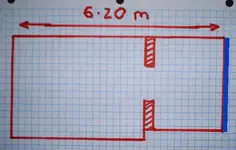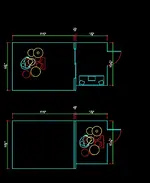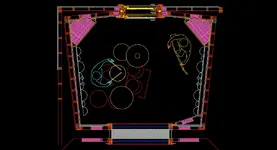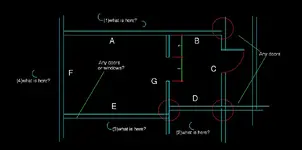Hello Jamye, Spain huh? Cool. Your english is very good english. Thankyou. Makes it easier to understand. Ok, lets start with isolation. What are your goals. Complete containment? Partial? None? Here is the deal.
As far as isolation from the household and outside world is concerned, have you any idea of how the existing conditions contribute to sound transmission loss? In other words, have you played a set of drums or other instruments in there already? If not, I would suggest doing so. Have someone play, and then walk throughout the house, and around the perimeter. This will give SOME idea of the level that is transmitting. Only YOU can tell if the existing barriers are suffiecient or not, where, and to what degree. Soundproofing is in the ear of the beholder. Your interpretation may NOT be the same as another occupant, or neighbor, but only you can determine what you hear. Once you can tell us what you are hearing, and where, and if it needs more isolation, this will give US, a little insight to what it will take to meet your isolation goal. Does that make sense?
And IF it does need to be modified to increase the STL(sound transmission loss) then we need to know everything we can to help you. So, communication is the name of the game here. What do you want to do? Isolate, Isolate and acoustically treat, or just treat the rooms? That is the question. In that regard, read the following if you need isolation. Treatment is a whole 'nother ball game, but if your buiilding new iso construction, it has a bearing on the acoustics also.
Ok, I need to clear up some things. First, I will post another picture of the plan with all walls labeled . You have confused me with RIGHT and LEFT descriptions, as you said the BLUE wall is a partition wall to a hallway. IT is on the RIGHT of my screen

You said the RIGHT wall is an exterior wall adjacent to a courtyard. See....hence the labling. It is EXTREMELY important to identify these walls, their COMPLETE composition and connections at all four intersections of each room. That is NOT ALL. You really need to understand the solutions demand comprehensive knowledge of existing conditions and materials. Also, a list of materials that are available to you there. Ok, here are some other things I need to know.
Existing floor......what is it, and how does it connect to the foundation.
Are the floors in each of these rooms one continuous floor? IF not, how are they connected. Usually, contemporary construction in the US, would require a foundation footing under each of the stone walls. IF, these stone walls had their own footings, they would USUALLY be integeral with a continous slab. However, since this is an OLD spanish construction, there is no way for me to know the conditions. Furthermore, since the partition wall is also stone, that tells me something. Are any part of this structure an ADD ON, or has it been remodled? I need to know everything, as the footings and floor connections will determine many things.
As I said before, there MUST be an EXISTING door into these rooms, but you
DON"T show it.

This is another MUST KNOW! I can't read your mind, so tell me EVERYTHING! IF, there is an existing door penetration WITHIN a stone wall, and you plan on covering it, or filling in the opening, that creates a different scenario than a complete stone wall. Understand? Also, you show a door in the partition wall. This is existing, no? Tell me the type of doors, frames, and trim that exist also.
Ceiling......tell me everything. I mean, THIS IS THE UPPER FLOOR.I want to know WHAT is supporting this ceiling(upper floor), what type of timbers, what size, how they connect to the walls, the direction of floor joists or, and which of these walls are SUPPORT walls. Even the one adjacent to the hall way may support the upper floor. Any HVAC penetrations in the ceiling? What is the ceiling material? Any insulation in the joist cavities? IF so what is it. Any electrical penetrations, like for lighting boxes or anything? We need to know EVERYTHING. You wouldn't withhold info from a doctor, right? Same here.
Walls. What type of stone. What is the EXTERIOR finish, and what is the INTERIOR finish on ALL of them. Any pipes, heaters, electrical, or anything that we should know. And do these stones connect to more than one wall at the intersections, like brick does? This makes a difference. The partition wall may only be stone up to a framing mechanism, or continue up through the second floor. Who knows. Since this is a two story structure, and the walls are stone, how do the second floor joists tie into to the EXTERIOR walls? What is it? Do the joists PENETRATE the stone wall? Any windows? We NEED to know this stuff in order to pre-empt any structural construction that may demand conditions for structural enforcement. Such as the joists. You can NOT add 2 layers of drywall to a 2x6 joist with a span that would cause it to deflect to the point of collapse. Understand? Even old connections could be rotted, or anything. Understand this. There are only TWO ways to prevent sound transmission. MASS, and decoupling. Mass translates into weight. Decoupling translates into knowing what exists in order to connect correctly.
Also, what is your plan for HVAC, as soundproof translates to AIRPROOF. Heat buildup in small rooms is quick. People, equipment, etc, demand at least a ventilation system that both supplys and removes air, whether treated or not. Tell us your intent in this regard. You will be sorry if you don't address this issue from the outset, as it has many implications, such as ducting, grills, penetrations, etc. And, is there any existing HVAC in the rooms? What heats and or cools these areas?
As far as the space use is concerned, you don't have enough as it is to fully contain a band at one time. So, your recording methodology dictates multitracking one or two musicians at a time. That tells me the best approach to the first decision, is to use the large room as a control room. This places the entry through the booth, or "studio", not the control room. So, I agree with trackrat on this one. It makes sense. However, this makes for an EXTREMELY small space to record in. More like a vocal booth, as putting a set of drums in there after isolation construction is added, will undoubtably be very cramped for a drummer.
Ok, that should keep you busy. I'll be back.








